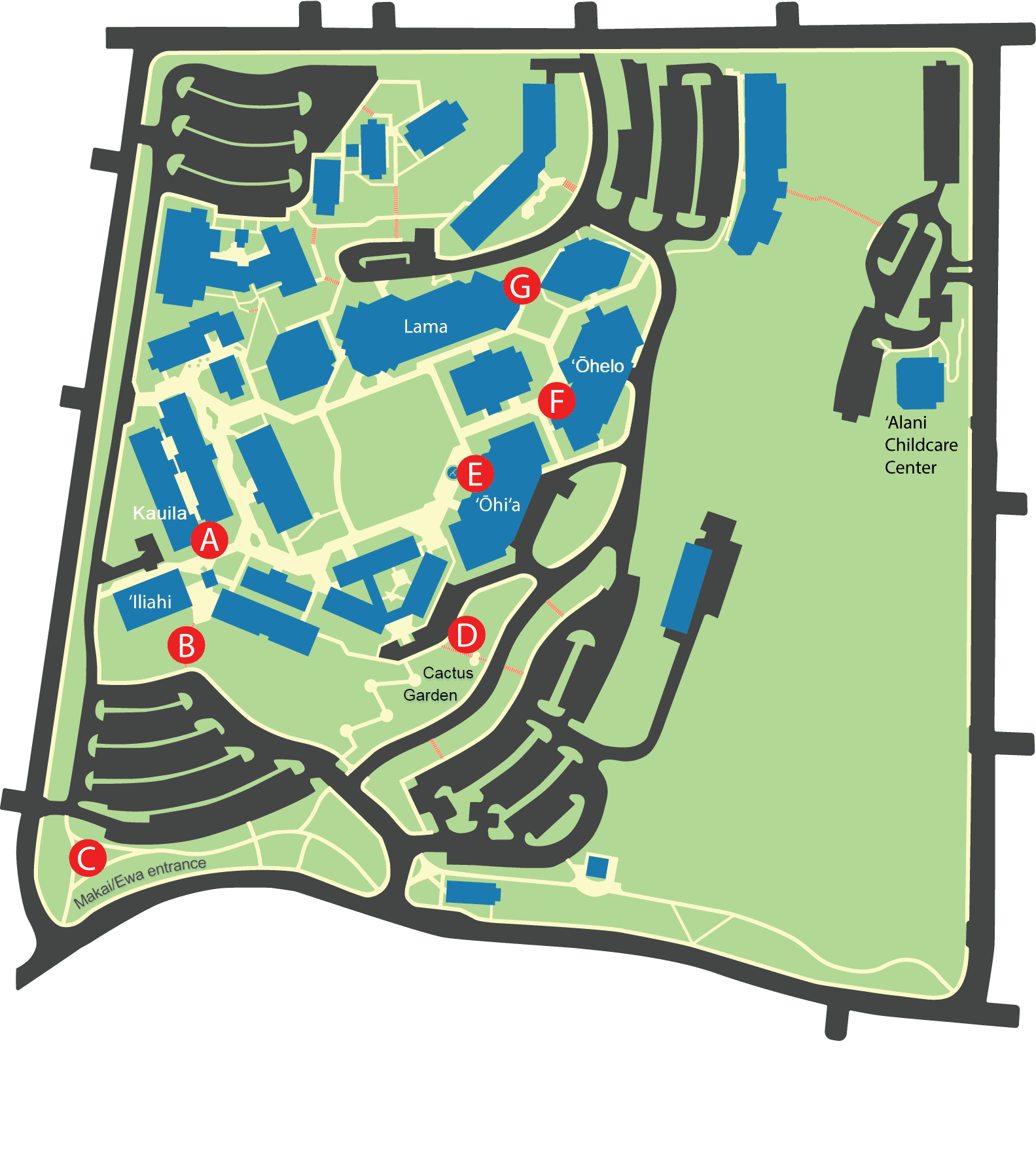Campus Art

Mark Kaulana Watson
Mai ka Mea Hāna Ka’ike, From Tools Comes Knowledge
Hawaiian Basalt Stone, 1987
Kauila Building
At the time of its dedication in 1988, Mai Ka Mea Hāna Ka Ike was Mark Watson’s largest work of Hawaiian basalt. The structure was carved and textured from an eight-ton boulder excavated from Kapi‘olani Community College’s Diamond Head campus, near its site of installation. The artist comments on his creative process: “I like the continuity of taking a rock from the excavation, carving it yet retaining and complementing its natural texture, then displaying it on a campus as a symbol of some aspect of the philosophy of education.” Mark Watson was born and raised in Hawai‘i and began his career as a carpenter. His interest in sculpture was sparked while helping his father, sculptor Chuck Watson, install some of his work. Mark then trained under his father for eight years, applying his skills with tools and his newfound passion for Hawaiian stone.
Sean Browne
Spirit Way
Sheet Bronze
ʻIliahi and Parking Lot B
The idea for Spirit Way, has its roots in the “porta” that marks the entryway to the Italian city and the “torii”, the gateway to the Japanese Shinto shrine. All three are intended to engage and raise the awareness level of the participant who passes from the outside world into the womb.
Sean Browne teaches sculpture at Kapiʻolani CC in the art department. “My work involves the discovery and use of archetype symbols to re-define our links to the past. The discovery of these universal symbols with fresh eyes, need not be immediate, as recognition often comes with the passage of time. With this in mind, I strive to create work that will endure through time.”
Kate Pond
All One
Gift From ASKCC, 2002
Makai/Ewa entrance to campus
All One encloses a time capsule that was dedicated in 2002. The time capsule is filled with artwork by young people from the four sculpture sites in Japan, Norway, Canada, and the USA and will open in November 2015. The sculpture faces east. In November the Makalʻi (Pleiades) rise as the sun sets, announcing the start of the Makahiki in ancient Hawaiʻi. The stones on the grass document the two times of the year in May and July when the sun is directly overhead.
Mamoru Sato and Bill Jones
Succulent and Cactus Garden
On Loan from The Contemporary Museum, 1989
Cactus Garden
Erica Karawina
Hawaiʻi Hawaiʻi
Faceted Glass Mural, 1988
Cafeteria
Erica Karawina has blessed Hawai‘i with splendid works in stained glass, using both conventional thin leaded glass and the more contemporary thin leaded glass dalle de verre—stunning in purity and brilliance of color. The artist uses dalles (inch-thick slabs of glass), fashions a design, saws the glass into shapes, and taps them with a hammer to create facets that capture and diffuse rays of light. After setting the pieces in place, she pours epoxy carefully between them to cast the panel in permanent form. Once Karawina discovered dalle de verre, she had found her medium. “Now I literally paint with light,” she has said. Whether in small stand-alone pieces or massive architectural walls and windows that must be hoisted into place with cranes, her creations radiate. Her more monumental windows and mural walls grace houses of worship and public buildings throughout the state.
She considers her greatest achievements to be two huge projects, each consuming three years of work: first, the four gigantic glass mosaic murals, representing morning, noon, afternoon, and night, at Kalanimoku, the state office building on Punchbowl Street across from the Capitol, and then the magnificent fifteen-ton glass mosaic skylight, Kapa Lele O Hawai‘i (Flying Tapa of Hawaiʻi), glowing with daylight sixty feet above the atrium floor of Ka’ahumanu Hale, the circuit court building at Punchbowl and Halekauwila.
Lucille Baldwin Cooper
Pohaku O Leʻahi
Ceramics / Water, 1984
ʻŌhelo Building
Pohaku (rocks) play an important part in the history and legends of Hawaiʻi. On our islands, stacked rocks can be found near trails to show the traveler the way. The direction. This trio of stacked pōhaku was created as a symbol of direction and will stand at Kapiʻolani Community College as a trail marker to inspire, guide, and embody the spirit of Hawaiʻi.
Lucille Baldwin Cooper was born in Shanghai, China in 1923, has lived in Hawaiʻi since 1947, and was the recipient of the Koa Gallery’s 1994 Koa Award.
Mamoru Sato
Sol III
Fiberglass, Steel, 1973
Lama Building – East End
Sol III was originally made for the Flora Pacifica Exhibition held at the Blaisdell arena in 1970. It was an exhibition that commemorated the countries surrounding the Pacific including the US, Central, and South America, Canada, Alaska, and those in the East such as Japan, Philippines, etc. It was created to represent the sun for the Americas section. In its original form, it was made of stretched vinyl. Before its display on the top floor of our state capital, it was remade in its present material of fiberglassed plywood. It was then shown at our airport for a number of years until it was finally taken to your campus.
Sato is best known for his abstract sculptures constructed of industrial materials, such as Sol III, which is made of fiberglass. Some of his commissions include sculptures for the Kona State Office Building, Maunawili Elementary School, the Rev. Benjamin Parker Elementary School, Honolulu International Airport, Hilo Hospital, Kapi‘olani Community College, the Pearl City Culture Center, and the Makai Parking Structure.






